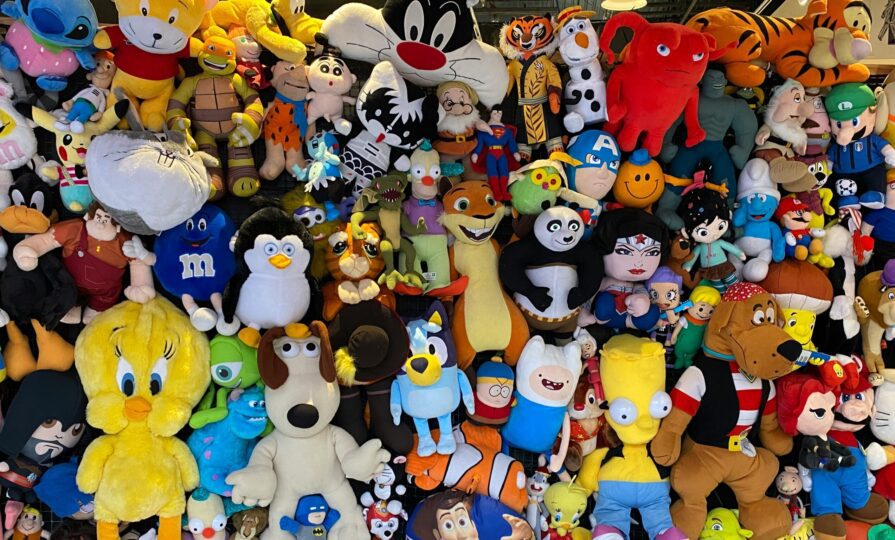It’s not all just fun and games
The UK toy industry reported that its annual sales dropped by nearly £200m in 2023. Sales dropped by 5% to £3.5bn, according to the annual toy industry report by the market research company Circana. While the sector attributed this decline to cash-strapped consumers, Retail Sector takes a deeper dive into the current state of the market and its outlook for 2024

The UK toy industry reported that its annual sales dropped by nearly £200m in 2023. Sales dropped by 5% to £3.5bn, according to the annual toy industry report by the market research company Circana. The report stated that the decline reflected the broader impacts of challenging UK economic conditions. So, is the toy industry losing its charm?
Alan Simpson, chairman of the Toys Retailers Association and owner of 32 Toytown retail stores spread throughout the UK, believes that the toy industry isn’t losing its charm or value. He claimed that the dip in sales “didn’t come as any surprise” to the industry; in fact, similar dips can be seen in France, Germany, and the US. The US experienced an 8% deficit. However, he adds that the decline doesn’t include the impact of inflation, and when that’s factored in, the dip is actually going to be a bit worse. He says: “The dip is global and not just in the UK, and it’s on the back of an economic car crash where inflation has been rampant, interest rates have been going through the roof, and the general cost of living. So when people are faced with actual mortgage payments, electric bills, or any other bills that are coming through on a monthly basis, there is a lot less disposable income. And in some cases, there is no disposable income. There are some people here who are struggling to make ends meet by paying for essentials. Nevermind luxuries like toys, which aren’t a luxury as such, but they are for some at this point in time.
“So that means that the industry is such that we’re not expecting the boom year we’ve had, but a 5% drop in the value of sales isn’t out of the ordinary. It’s just one of those things that, you know, every industry—not just toys—has felt the impact of the cost of living. By mid-year, we were well up. But the deficit sort of came in the second half of the year, which ties in with what I’m saying there because the impact of all of inflation, mortgage interest rates, etc. didn’t really take hold in the first few months of the year, but it was in the second half that it really impacted.”
The other unfortunate impact is shoplifting. Simpson states that there are some out there who, when they can’t afford something, turn to shoplifting. As a result, there has been a marked increase in incidents of shoplifting, both in toys and in retail in general. He also claims that the police don’t really seem to be interested in stemming it and that “it is high time that they addressed the issue and started enforcing the law, or not choosing what laws they enforce”.
Similarly, Carmel Giblin, CEO of the IETP Ethical Toy Program, stated that even though the toy industry struggled in 2023, during COVID, the sector reported some incredible results as many children around the world were homeschooled. She says: “There was a huge uptick in demand for toys, particularly toys that had some sort of development aspect to them. So I don’t, and I don’t think it’s losing its appeal or attraction. The toy industry is all about innovation and new product development. So it has to keep evolving, and there’s a huge churn in the number of products that are made every year. It’s very fashionable. I think you often have companies performing really well one year, and maybe their product is not in fashion the next year. In my experience, the toy industry is very resilient. It’s very innovative. And I think if the industry makes good products, then consumers will continue to purchase them.”
While challenging economic conditions have led to a decline in sales, other factors like excess screen time and the introduction of new electronic gadgets have also significantly affected the industry. Giblin says: “I definitely think electronics, online content, and online gaming are a huge part of how children use play or entertainment. It is just part of the category now. What we’ve seen is that children are moving in or out of the categories at a faster pace. So where you would have had my generation play with dolls or toy cars for a longer period of time, that’s much younger now. I think children with traditional play are probably younger, but it’s still a huge part of every child’s life. So there is a mixture, and if you look at products like Lego, they continue to have huge success with their products because they are durable, they’re very sustainable, and they last for a very long time. Kids continue to come back to them, proving to be product-dependent.”
As Giblin noted that toys are fashionable, transatlantic entrepreneur and tech and toy expert Heather Delaney, MD, and founder of Gallium Ventures, discusses how the market is attempting to adapt to the demands of different age groups in order to remain trendy and relevant. She says: “With parents and siblings often glued to their devices, it would be hard to expect children not to do the same. Toy makers have adapted to this new paradigm— today you can find baby toys in the shape of mobiles and tablets. However, that’s just one side of the coin. Flip it and you’ll find that adults’ nostalgia for their own childhoods has prompted collectable toys to take centre stage, along with 80’s and 90’s classics and an ever-growing range of board games and card games. On top of this, we see a revival of wooden toys, which allow children to play with different types of blocks, baking sets, doll houses, play sets, and more. These will be the ones to keep an eye on in 2024, along with the Barbie takeover, which will continue, and a variety of STEM toys.”
Delaney also looks at how the market has evolved and changed over the years as it tries to keep up with new technology. She explains that as digital technology has evolved to capture the hearts and minds of children, so has the physical toy industry. For example, there are a number of toys with built-in coding to cater to parents that want their kids to learn through play, or toys that have augmented reality (AR) and virtual reality (VR) looped into a product, easily available in the home.
On the other hand, she emphasises that toys are not just for kids. As shown by 2023 consumer research from The Toy Association, 89% of parents were also going toy shopping for other adults during the holiday season, while 41% of them had bought toys for themselves in the past 12 months. Delaney stated that she doesn’t find this surprising as during the pandemic, there has been an increase in adults choosing toys like LEGO or 3D puzzles to both channel their creativity and de-stress.
Melissa Symonds, executive director, UK Toys at Circana also states that the UK Toy market is always evolving with up to a third of annual toy sales coming from new items and ranges. In the last few years the sector has seen an increase in Kidults – toys purchased for 12+ years which now accounts for 29% of annual sales and grew by +6% in the last year. This is particularly important in games, building sets, plush and action figures categories with social games experiencing particularly strong growth. The industry has also seen collectability growing – accounting for 21% of all toy units or volume sold. This ranges from collecting trading cards and stickers, mini dolls and action figures through to full Plush ranges.
However, while the toy market is trying to keep up with new trends and technology, there are a few things that retailers lack, according to Giblin. She claims that the toy retailers have lost some kind of theatre. She says: “The factor that affected the toy sector was the rise in online shopping thanks to Covid, which led to the closure of many retailers. It’s quite difficult to recreate the same theatrical experience virtually. But the big news in the toy industry right now is that Tesco, the retailer, has partnered with The Entertainer, which is a major specialist toy retailer, to take over all the toy categories in Tesco stores. I think that’s big news, because it shows that a big retailer like Tesco is excited about the toy category, but at the same time also understands that maybe a specialist toy retailer can perhaps do a better job.
“People want excitement in the fixtures when you’re looking at them. They want to see great products and be able to really touch and feel them. Retailers have to give space to toys. They have to create excitement around it, and obviously, sustainability is a huge part of that.Customers are keen on sustainability, especially millennials and Generation Z. Plastic is a common material found in toys, and it’s not single-use plastic either. There are very few toys that are single-use; in fact, none , so even though they aren’t, they can be associated with that and have some unfavourable connotations. Today, consumers want to buy products that are ethically produced and that respect not only workers but also the planet. And I think there’s an opportunity for retailers to make it easier for consumers to purchase in line with their kind of expectations around ethical sourcing.”
Simpson also agrees that, from a sustainability point of view, the sector has always been proactive. He says: “If you look at Lego, for instance, Lego bricks are made of plastic. But they’re not single-use plastic. They’re made of plastic, bricks, and toys that will last for years and be handed down from generation to generation. I’m 60 now, and my children were playing with Lego bricks that I played with. So that, from a sustainability point of view, is a testament to how the industry actually thinks.”
Additionally, delving into Giblin’s point about the loss of theatre in the sector, Delaney states that retailers should invest more in both PR and creative experiential, building great awareness and affinity while making in-store shopping more of an experience that customers will actively seek out. She explains: “Digital plays a part here, too, when combined in-store to create experiences that can be personalised to a greater degree. On top of this, the marketing and sales approach when targeting kids vs. adults should vary significantly, as dictated by both the platform used and the type of subtle, or not so subtle, messaging.”
Despite the fall in annual sales, according to Circana’s recent report, consumers’ demand for toys remains strong, with several toy categories achieving growth. Sales of toys priced from £15 to £20 were the only price category gaining sales, showing that consumers opt for more mid-point items in an economic downturn. However, over 63.5% of toy units sold are still priced under £10, contributing to a significant 28% of the market’s overall value. This signals that affordability and value for money are top priorities for consumers during these uncertain times.
Buoyed by top toy movie blockbusters, licensed toys continued to play a vital role in the market dynamics of 2023. The sector reported sustained growth for the fifth consecutive year, with market share increasing to 32% from 26% in 2020, surpassing last year’s highest-ever market share by 1%. Giblin says: “I think what is a huge part of a company’s success in the toy category is licensing. If you look at Mattel this year, you have the huge Barbie movie that directly impacted Mattel’s success this year. Sales of Barbie have increased year on year. Barbie would have probably been just any other doll in the doll category and would have probably been one of those ones that was in decline. However, with a very strong on-screen product, it’s brought people back into that category. So they kind of go hand in hand with online content, whether it’s through gaming or other features online or through big films.”
The report stated that, looking ahead, the market is expected to stabilise in 2024, with a greater emphasis on evergreen licences and original toy brands. Giblin also has a positive outlook for 2024. “In general, talking to people in the industry, we are quite positive. Even with the existing financial pressures, consumers want to give their kids, grandchildren, etc. great products to play with. I think things like The Entertainer taking over the toy category at Tesco is really exciting. So I think 2024 is going to be a good year for the industry,” says Giblin.
Delaney adds: “For those that haven’t yet embarked on this journey, 2024 will be an inflection point in transforming how toy makers and retailers need to target consumers. A lot of brands still rely on legacy, though the benefits here will fade year after year. To prevent diminishing returns, brands and retailers need to work hand-in-hand for mutual benefit—create places where people want to go, filled with products they know of and want to buy. The aim of the game is to think outside the box and do things either you or the industry haven’t done before. Surprise people. Delight them. Then keep converting.”
Simpson, too, has a positive outlook for the toy industry. He’s in agreement with Circana’s report that the year 2024 will see more consumer confidence. He concludes: “Consumer confidence is one of the big things that impacts retail in general. If the consumers out there are confident and feeling good, they spend money. If they’re feeling apprehensive about things, they pull back. However, I’m confident, and I think the economic outlook is that inflation will fall even further and interest rates are likely to start falling this year pretty soon; therefore, that will instil the feel-good factor back in consumers. There’s nothing that we need to do better to enhance our performance; we’re there, and we’re ready for it. But if consumers don’t spend because they don’t have the confidence to actually part with money, that is the big impact.”



